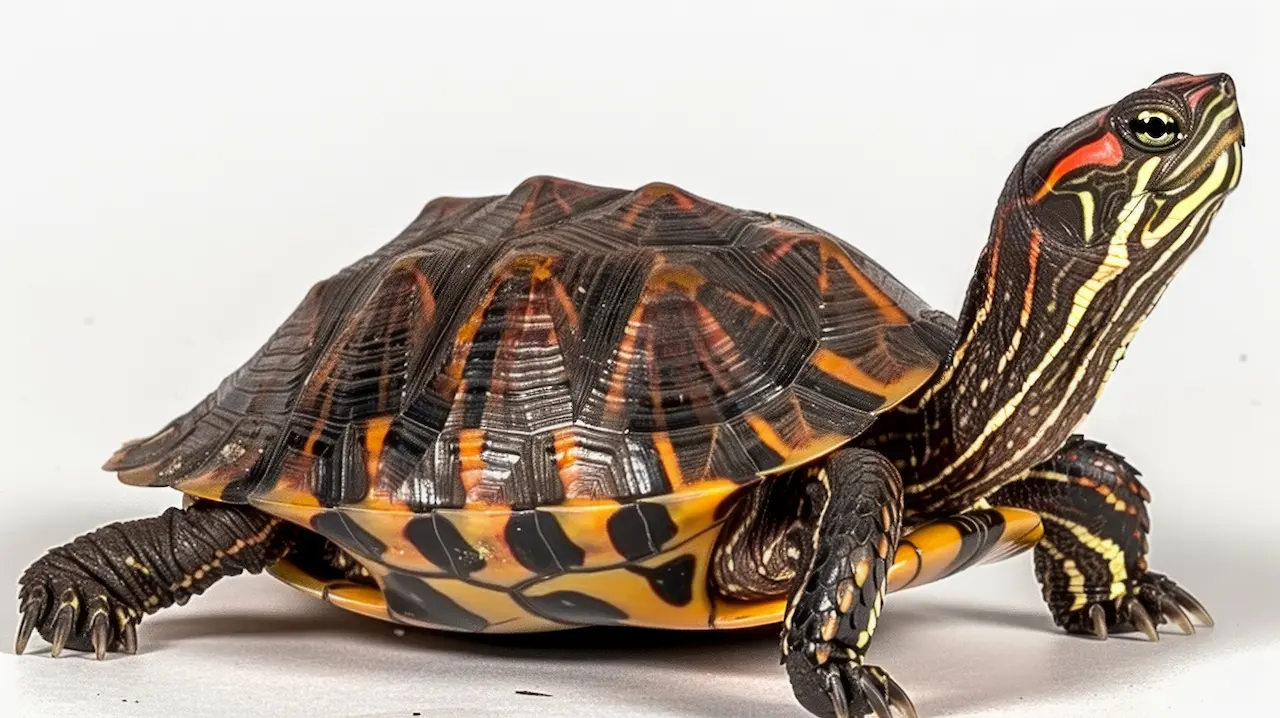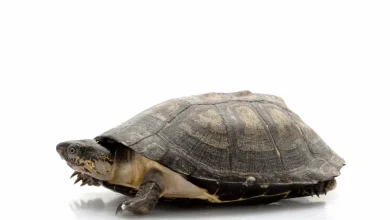Many people ask, Can an Eastern box turtle make a good pet? The answer is yes. Not only are these reptiles fascinating to watch, but they’re surprisingly easy to care for once you know their needs. Eastern box turtles have a gentle temperament, vivid markings and a curious personality that make them suited to both novices and experienced reptile hobbyists.
Table of Contents
Eastern box turtles do not require complex equipment or setups. The turtles thrive in a well-maintained, secure habitat that allows them to access both shallow and deep water. They also eat a lot of leafy greens and fruits, and other protein sources such as worms and bugs. These turtles are healthy and active with the right combination of diet and environment.
The Eastern box turtle is a great pet if you want a low-key animal that’s visually appealing and has oodles of personality. Here’s a guide to keeping your new turtle happy and healthy!

What is an Eastern Box Turtle?
Eastern box turtles, also known as terrestrial reptiles, are native to the eastern United States. They are not aquatic turtles and live mostly on land. They inhabit moist forests, grassy fields, and meadows. They can be recognised by their high-domed, hinged plastrons (the bottom of the shell) and ability to completely close inside themselves as a form of defence against predators. Turtle enthusiasts are attracted to their unique ability and colourful markings, as well as the calmness of their behaviour. Eastern box turtles, with proper care, can live several decades. Some even reach 50 years in captivity. They are a long-term investment for any potential pet.
Box turtles need specific conditions to thrive. They don’t require a litterbox or daily walks, like cats and dogs. Box turtles need UVB or natural sunlight, a humid and warm environment, as well as a varied diet. They are very sensitive to poor care and can rapidly decline in health if neglected. There are also several different species and subspecies, including the Coahuilan, ornate and three-toed box turtles, each with their own care needs.
What Does an Eastern Box Turtle Eat?
It is important to feed your Eastern box turtle correctly in order to maintain its health and well-being. Box turtles are omnivores and need a balanced, varied diet. If your turtle is kept outdoors, it will likely forage for insects, plants and worms on its own, supplementing any food you give. It’s important to provide a variety of fruits and vegetables as well as protein sources such as insects, low-fat beef, and even pinky mice. Some turtle owners choose to feed their turtles high-quality commercial pellets, but they should not replace them with fresh, whole food.
Always place your food on a clean, flat surface, such as a ceramic tile or paver, to ensure that mealtimes are safe and sanitary. This will prevent your turtle from accidentally eating substrate, which could lead to digestive problems. Young turtles need to be fed daily because they have a faster metabolism. Healthy adults, however, may only need feeding every two days. Consult a veterinarian who is familiar with reptiles to determine what portion size and feeding schedule will be best for your turtle.
Eastern Box Turtle Size
Eastern box turtles have a moderate size, usually growing between 10 and 15 centimetres (four to six inches) long. They are slightly larger than their box turtle relatives but still manageable for a pet. The compact size of these turtles is part of their appeal. They’re big enough to be interactive and sturdy, but small enough to fit in an enclosure that has been designed well, whether it’s indoors or outdoors.
The Gulf Coast box turtle is the largest subspecies of box turtle, reaching up to 8 inches in length. The Eastern box turtle is a more manageable size, making it a good choice for those who are looking for a low-maintenance, long-living companion. The Eastern box turtle’s manageable size, combined with its colourful shell patterns and curious nature, makes it ideal for beginners and experienced turtle lovers alike.

Eastern Box Turtle Behaviour
Eastern box turtles have a diurnal lifestyle, which means they are active at daytime and sleep at night. They hibernate (technically known as brumation in reptiles) for the winter in northern climates. They prepare by digging into soft soil, stream bottoms or rotting stumps. Many individuals return to the same hibernation sites year after year. This is a testament to their territorial knowledge and strong homing instincts.
They are known for being solitary, but also curious. They are not afraid to explore their environment, even though they avoid social interactions with other turtles except for mating. Many box turtles become very personable once they are accustomed to their environment and their handler. They may even recognise them. Enrichment, such as logs and plants, or safe hiding places, can keep the turtles mentally stimulated, while encouraging natural foraging behaviours.
Box turtles have one of the most powerful defence mechanisms among reptiles. When threatened, their hinged plastron allows them to seal themselves completely inside the shell. The turtles retract their legs, tail, and head tightly, and then clamp closed, creating a barrier that is nearly impenetrable. The ability to retract their head, legs and tail tightly gives adult Eastern box turtles a distinct advantage over most predators. The combination of adaptability, resilience and charm makes them fascinating pets for dedicated keepers.
Keeping Eastern Box Turtle Healthy
It takes a lot of time and effort to care for an Eastern Box Turtle, but with the right treatment, it can live for many decades, even up to 100 in captivity. Routine veterinary care will ensure that your turtle is healthy for the rest of its life. Schedule at least an annual visit with a veterinarian who is experienced in exotic animals. It’s important to regularly screen for parasites if your turtle is outdoors. Parasite infections are one of the most common health problems. These conditions are often difficult to detect, but abnormal feces may be a sign.
A turtle’s respiratory infections can be a problem, especially if the environment is too hot or cold. Vets should address symptoms like wheezing or laboured breathing as well as nasal discharge immediately. Respiratory illnesses can quickly worsen if left untreated. Preventing respiratory illness requires maintaining the right humidity and temperature.
The health of the shell is equally important. A clean, strong shell is an indication of a turtle that has been well cared for. Look out for any signs of shell rot, ulcers or discolouration. This is often due to poor nutrition or unhygienic conditions. It requires veterinary care.
You can ensure that your turtle will live a long and happy life by providing it with a healthy, clean and balanced environment.

Important Tips on Handling Eastern Box Turtles
Eastern box turtles may not be the most cuddly pets, but they can form strong bonds with their caretakers and have gentle interactions. Turtles are generally not fond of being handled often. They feel safer when they’re left in their natural habitat. But that doesn’t stop you from interacting with your turtle. Many box turtles will accept food from your hands or feeding tongs with time and patience. Some even enjoy a gentle shell rub. These interactions help you build trust with your turtle and give you a better understanding of its personality.
Handle your turtle with gentleness and care to reduce stress. This is true whether you are cleaning it, performing a health check, or changing its enclosure. To avoid jarring it, always pick up the turtle from below. Support the body and shell firmly, but gently. A turtle that is dropped can result in serious injury. Hands should be washed before and after handling turtles, since they can carry bacteria such as Salmonella. Your box turtle will become curious and rewarded with calm, respectful interactions.
Conservation of Eastern Box Turtles
Although the Eastern box turtle’s population isn’t listed as endangered on a national level, it faces increasing pressure in several regions. Several states, such as Michigan, New Hampshire, Massachusetts and Connecticut, have classified the species under special concern because of its noticeable population declines. The turtle is endangered in Maine. These designations are meant to highlight regional threats that may not be visible at a larger scale but pose serious risks for local populations.
Eastern box turtles are primarily threatened by habitat destruction due to urbanisation, collisions between turtles and vehicles when they cross the road, and illegal collections for the pet market. Due to their long lifespans and the relatively low reproduction rate of these turtles, even a small decrease in population can have a long-lasting effect. Conservation efforts are focused on protecting habitats and raising public awareness. They also enforce wildlife trade regulations and encourage responsible pet ownership. Understanding the pressures that these turtles are under can help us protect and preserve them in the wild.



